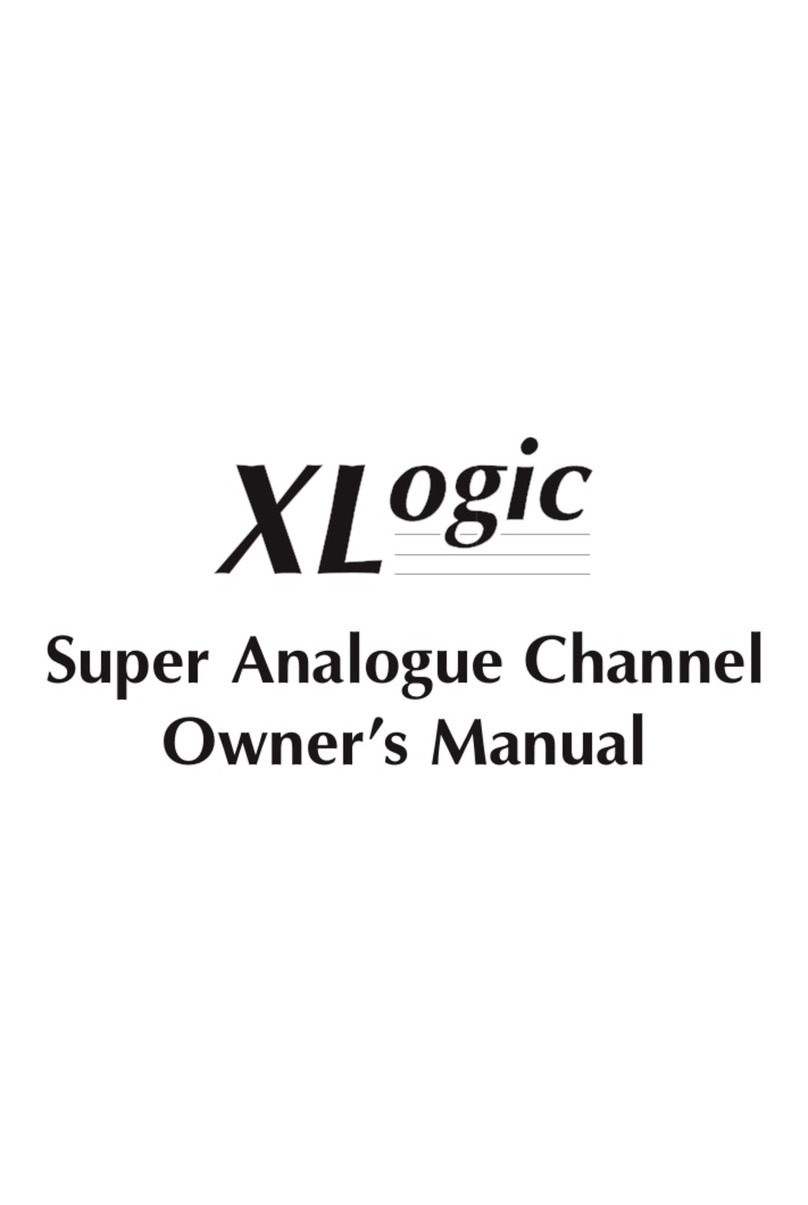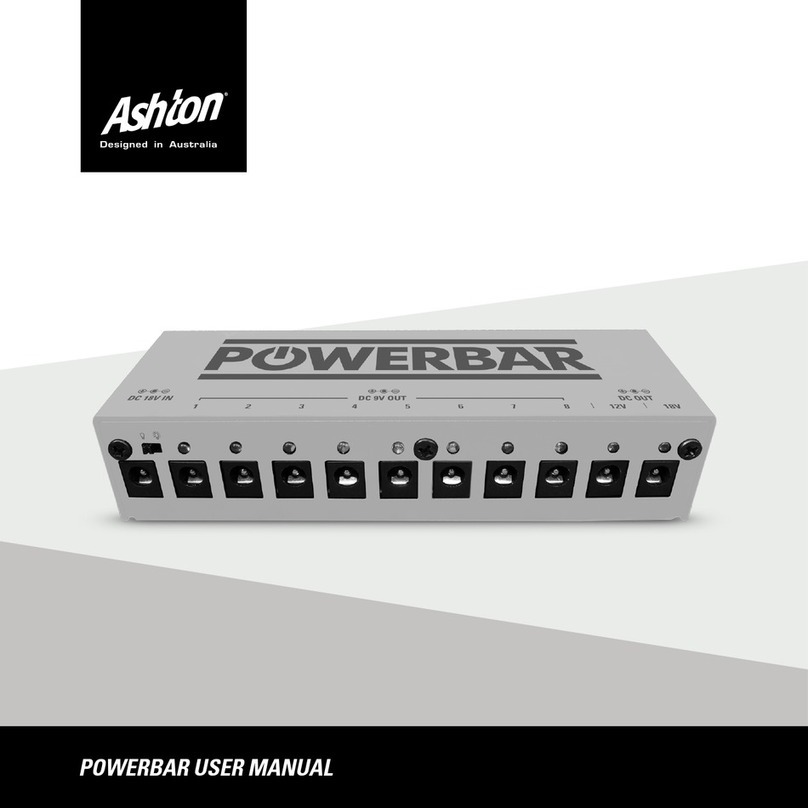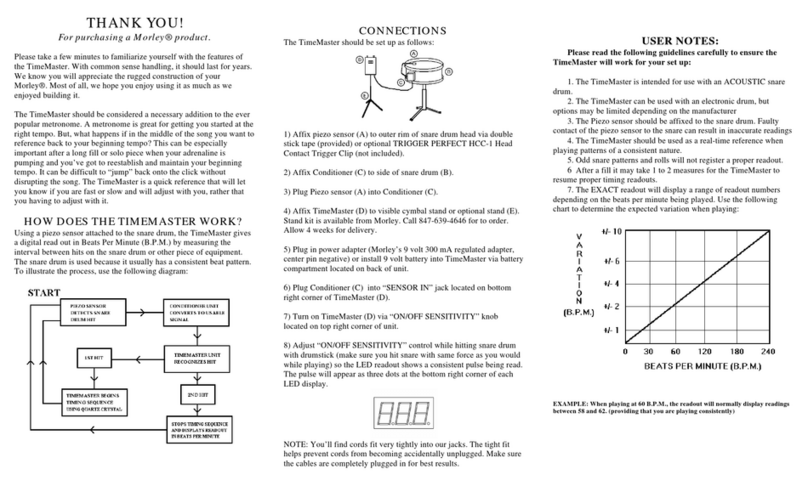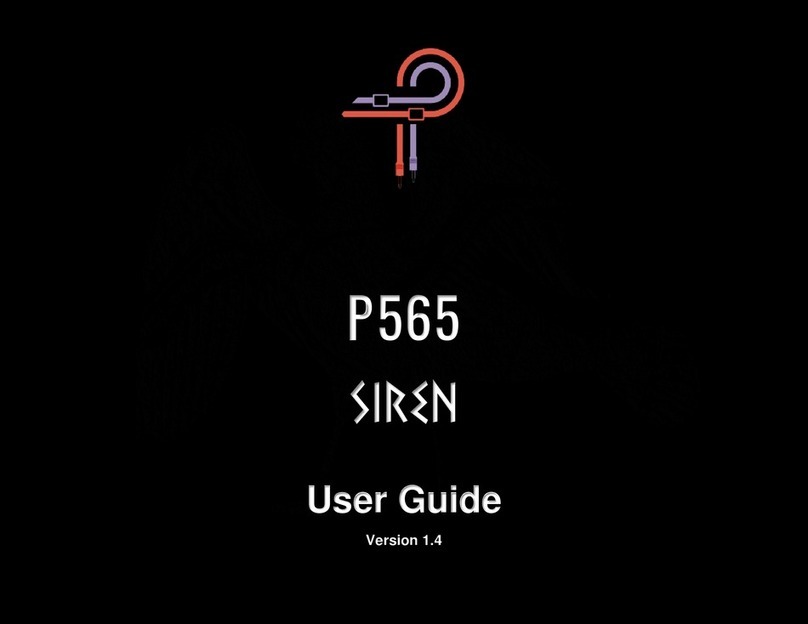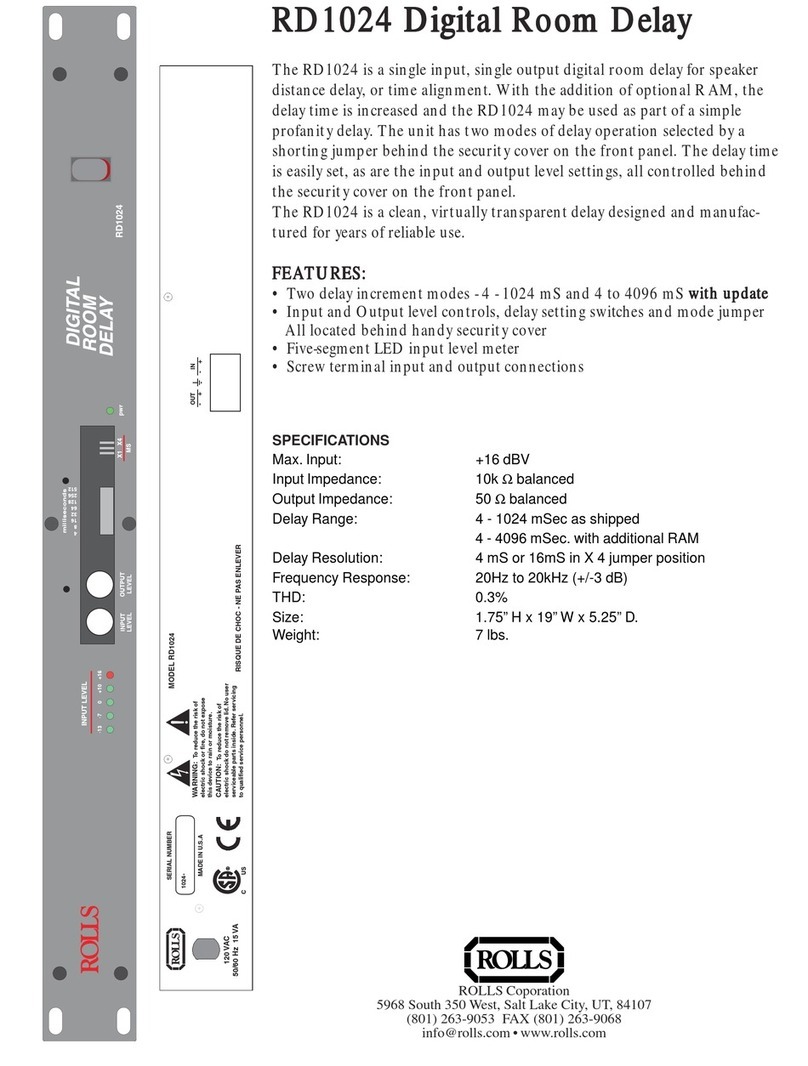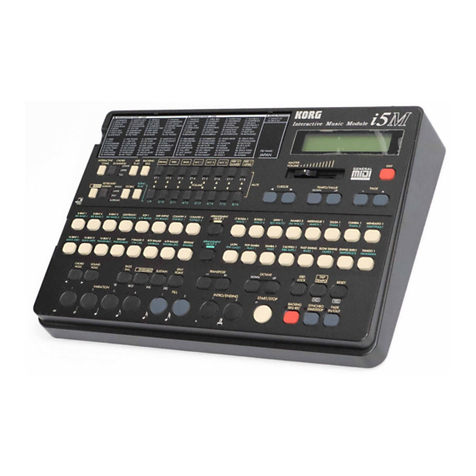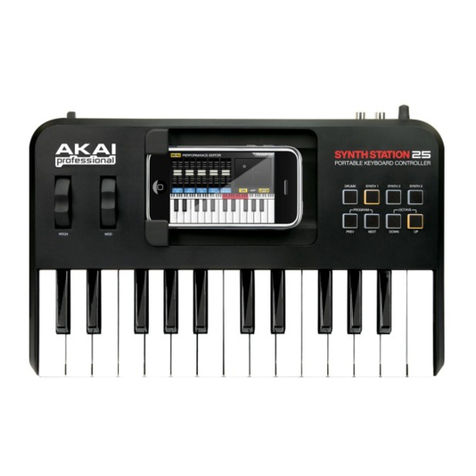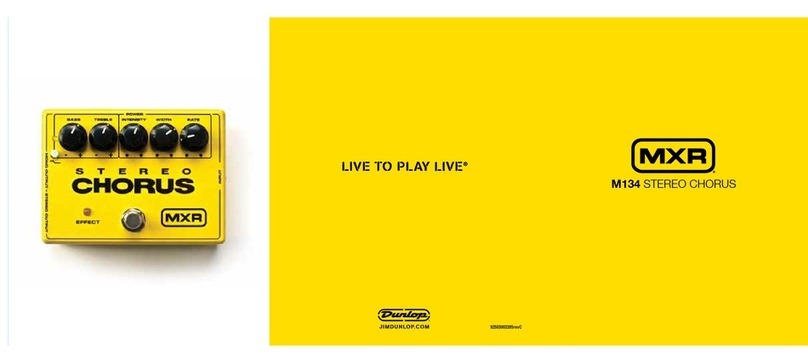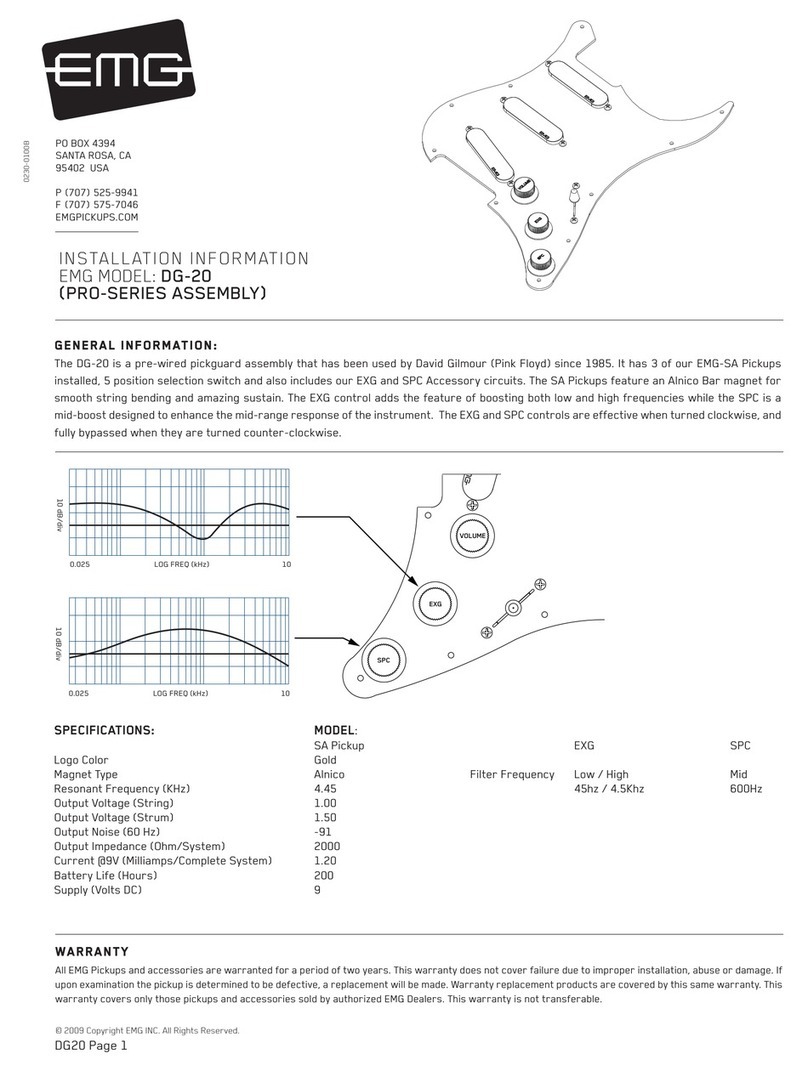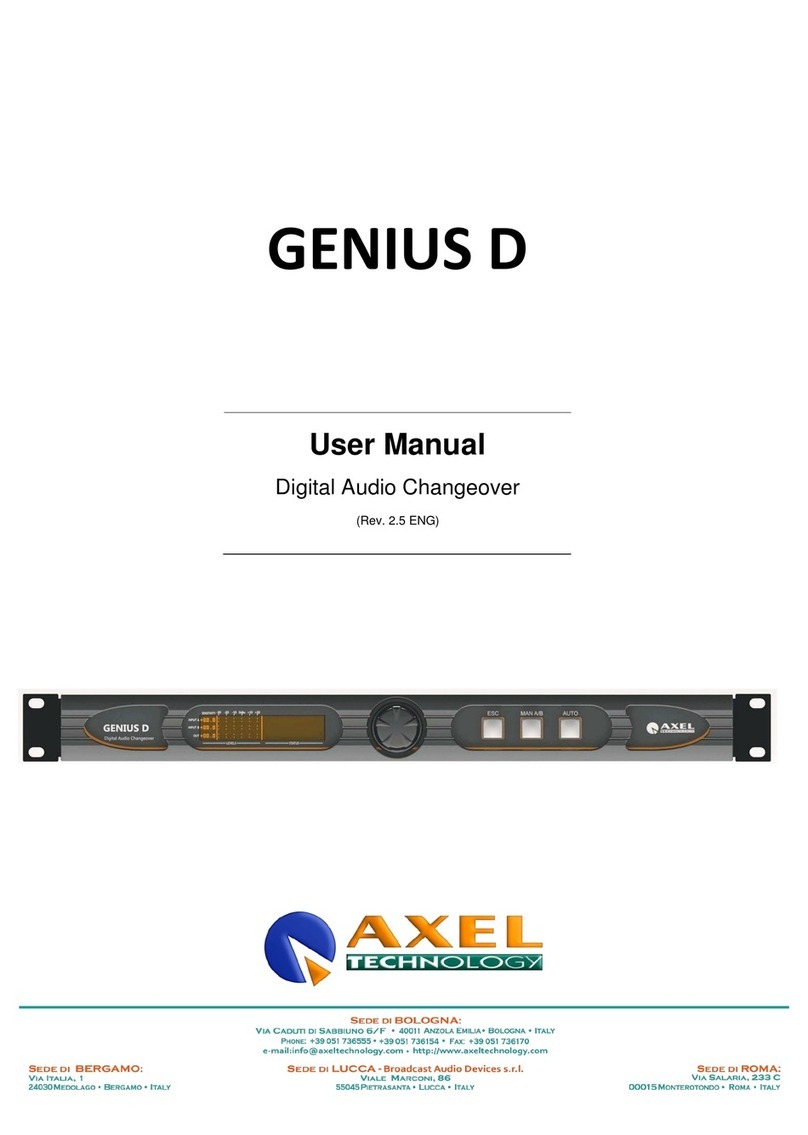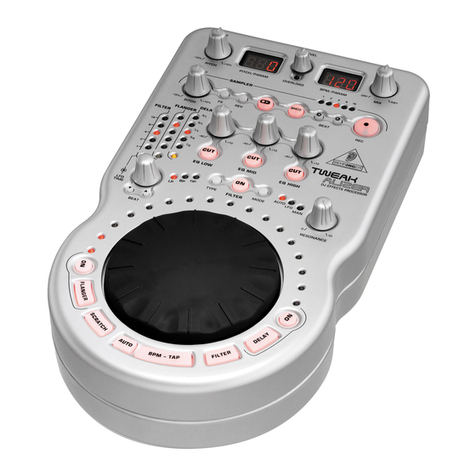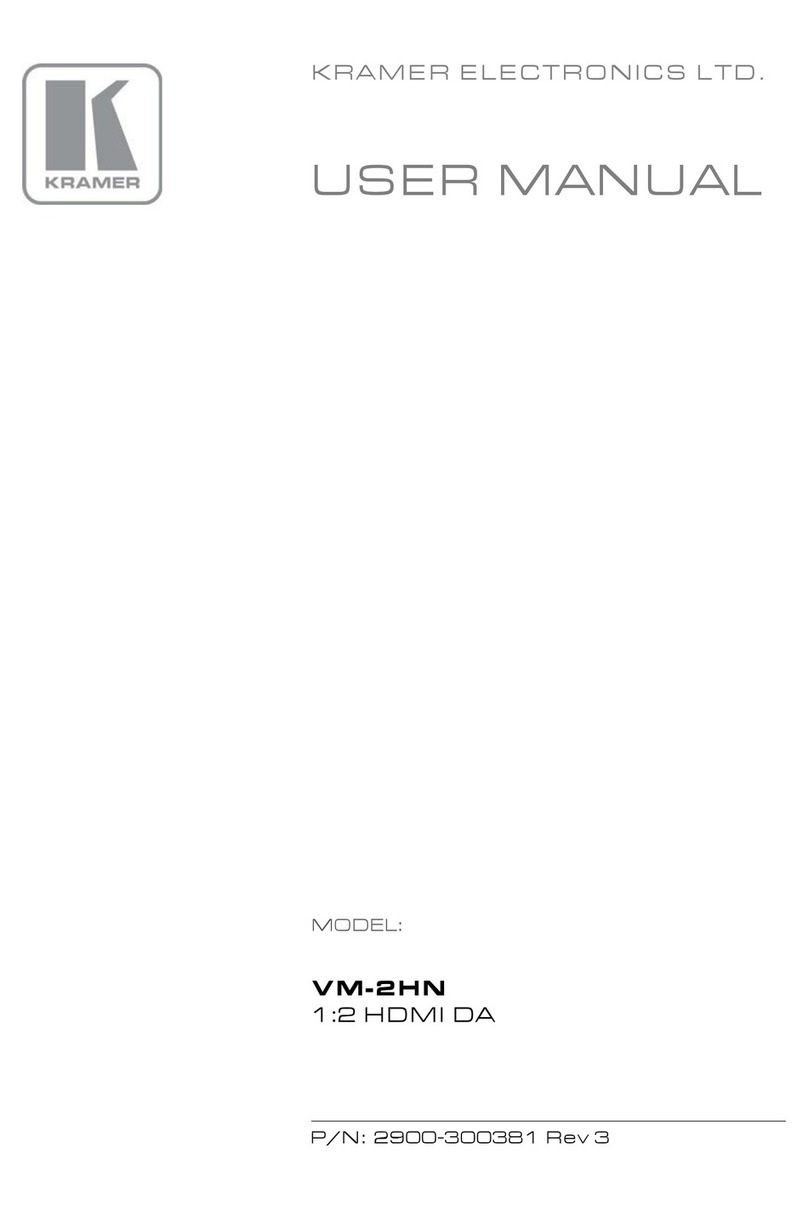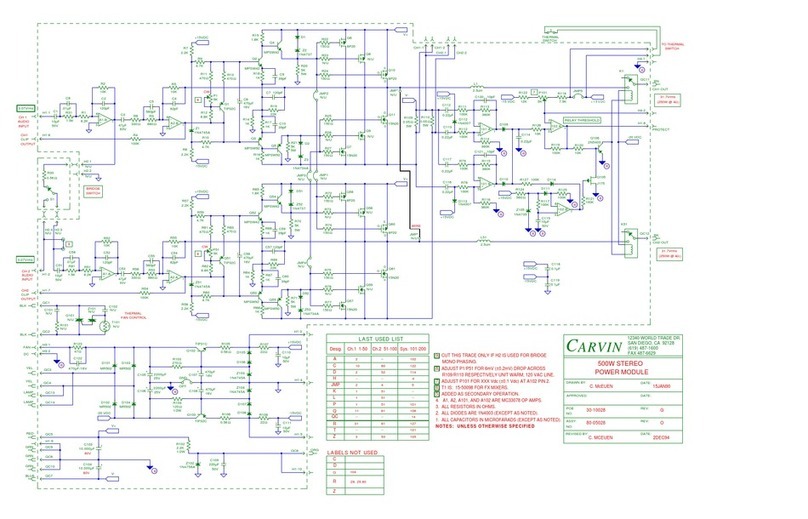MFB Tanzbar User manual

User Manual

3
Overview
What is Tanzbär...? 4
User Interface 6
Setup
Backside 7
Frontpanel 8
Play Modes
Manual-Trigger Mode 10
Play-Mode 10
Soundengine
Instruments 14
Record Mode
Modes Overview 17
Pattern Programming 18
Synth-Tracks 21
Scales and
Pattern Lenght 22
Store Pattern 23
Clear Pattern 23
MIDI
MIDI Clock 24
Step-Output 24
Drum Expander Mode 24
SysEx Data 25
MIDI Controller 25
CV/Gate, Sync 26
Setup Functions 28
Appendix
MIDI Implementation 30
User Manual
Content:

MFB Tanzbär
5
Overview
MFB TanzbärOverview
4
OVERVIEW
MFB says „thanks“!
First of all we would like to thank you for purchasing the Tanzbär. We appreciate your
choice very much and hope you will have lots of fun with your new instrument.
What is Tanzbär (”Dancing Bear”)?
Tanzbär is a drumcomputer, featuring a real analogue soundgeneration and a very sophis-
ticated, pattern based stepsequencer. It sports some advaced circuitry of the MFB drum-
mies MFB-522 and MFB-503, as well as some features that are completely new to MFB
instruments.
What‘s exacty going on inside Tanzbär? This is a brief overview of it‘s functionality:
Soundgeneration:
• 17 drum instruments with 1 to 8 tweakable and storable parameters.
• Level pots on all drum instruments plus master volume (not storable).
• Individual outs (in pairs except claps).
• Simple synthesizer for lead- and bass sounds with one parameter each.
Sequencer:
• 144 patterns (on 3 sets resp. 9 banks).
• 14 tracks triggering the drum instruments.
• 2 tracks for programming note events (output via MIDI and CV/gate).
• Combination of step number (1 to 32) and scaling (4) allows all kinds of beats.
• A/B pattern toggle
• Roll/Flam function (multiple triggering)
• Fill function (chaining patterns - not storable).
• Track mute function
The following functions can be programmed on each track (drum instrument):
• Track lenght (1 - 32 steps)
• Shufeintensity
• Track shift (micro delay of entire track via MIDI controller)
The following functions can be programmed on each step (drum instrument):
• Step on/off
• Accent level
• Sound setting of current instrument
• Bend (pitch modulation - only DB1, BD2, SD, toms/congas)
• Flam(multitrigger=am,rollsetc.)
• Additional sound parameter (on selected instruments)
The following functions can be programmed on each step (CV tracks):
• Step on/off(output via MIDI note-on and +/-gate)
• Pitch with 3 octave range. Output via MIDI-notes and CV
• Accent level (on bass track only)
• 2nd CV (on bass track only)
Operation Modes
Manual Trigger Mode
• Triggering instruments via step buttons and/or MIDI notes (with velocity).
• Access to sound parameters via knobs or MIDI controller.
Play Mode
• Pattern selection
• Access to sound parameters via knobs
• Accesstoplayfunctions(A/Bpatterntoggle,roll-,ll-,andmutefunctionandsome
more)
Record Mode
• Programming a pattern in one of three available modes (Manual-, Step- or Jam-
Mode)
Synchronisation
• MIDI clock
• Sync signal (clock) and start/stop input or output; output clock devider
Not bad, uh? Of course it was not possible to place a dedicated knob or button for each
function on the front panel. Sometimes a second function level and some button combi-
nations have been necessary to access all features. To ensure that you and your Tanzbär
will become friends as soon as possible, we really advice you to read this manual carefully.
This will be the best and most easy way to explore your Tanzbär entirely - and there‘s pret-
ty much to explore. So we beg you: please read (and understand) this f... manual.

MFB Tanzbär
7
Setup Functions
MFB TanzbärOverview
6
The User Interface
As just mentioned, most of Tanzbärs buttons cover more than one function. Depending on
theselectedmode,thefunctionalityofthebuttonsmaychange.Thefollowinggurewill
show you which modes and functions are related to certain buttons.
Please note that this is just an overview. You may use it mainly as an orien-
tation guide. The complete functionality and the necessary operating steps
will be explained later in the text. Please feel free to read on.
Sound-Parameter
select Mode
Function-Buttons
in Play-Mode:
- Accent (for Rolls)
- Roll-Function
in Record-Mode
(Per-Step-Programming):
- Accent
- Bend-Function
- add. Sound-Parameter
- Flam-Function
select Pattern
(in Play-Mode)
2.Fctn-Level
Shuffle-Fctn
Start/Stop
select /
confirm
Tempo (Shift) /
Sound-Parameter
Pattern A/B toggel / copy
chain Patterns
(in Play-Mode)
Step-Buttons
in Play-Mode:
- Pattern-Selection
- Instrument-Selection (Man-Trg-Mode)
- Function-Selection (with Shift)
- Parameter-Values
in Record-Mode:
- Track-Selection
- Step-Selection
- Function-Selection (with Shift)
- Parameter-Values
CONNECTIONS AND INITIAL OPERATION
Connections on Backside
Power
Pleaseconnectthe12VDCwallwardhere.Powerup/downTanzbÊrwiththeON/OFF
switch. Please pull the power supply off the wall if you do not use the Tanzbär for longer.
Pleaseuseonlytheincludedpowersupplyoronewithexactthesamespecications-no
exceptions, please!
MIDI In1 / MIDI In 2 / MIDI Out
Please connect MIDI devices here. MIDI keyboards and drum pads should be connected to
MIDI In 1. MIDI In 2 handles MIDI clock data exclusively. Via MIDI out, the Tanzbär sends
out note date of all tracks.
Audio Outs
Tanzbär features one main audio out and six additional instrument outs. The latter are ste-
reo jacks which send out two instrument signals each - one on each channel (except the
clap – this is a stereo sound). Please hook up the outputs with insert cables (Y-cables). On
clap, please use a stereo cable.
If you plug in a cable on an instrument out, the sound is erased from the main out. Please
connect Tanzbär‘s main out to an audio mixer, soundcard or amp, before you power
Tanzbär up.
• BD Out left: Bassdrum1, right: Bassdrum 2
• SD/RS Out left: Snaredrum, right: Rimshot
• HH/CY Out: left: Open/Closed Hihat, right: Cymbal
• CP/ClapOut: theattack-transientsarespreadoverthestereoeld
• TO/COOut: threeToms/Congasspreadoverthestereoeld
• CB/CL Out: left: Clave, right: Cowbell

MFB Tanzbär
9
Play Mode – Playing the Tanzbär
MFB TanzbärSetup Functions
8
Connections on panel top
OnTanzbär‘stopyouwillndit‘sCV/gateinterface.Itputsoutcontrolvoltage(CV)-and
gate signals of both note tracks. Next to this, a start/stop signal and a clock signal is sent
or received here.
• CV1: Output of pitch-CV track 1 (lead synthesizer)
• CV2: Output of pitch CV track 2 (bass synthesizer)
• CV3: Outputoflter-controlCVtrack3(basssynthesizer)
• Gate1: Output of gate signal track 1 (lead synthesizer)
• Gate2: Output of gate signal track 2 (bass synthesizer)
• Start: Sends or receives start/stop signal
• Sync: Sends or receives clock signal
To explore most of Tanzbär‘s features, you will simply need the power connection and the
main audio out.
Power-
Supply
MIDI-Keyboard
MIDI-Clock
MIDI-Notes
MIDI-Notes
12V DC
Sync Start
Gate
CVs
Wall-Outlet
MIDI-Sequencer
MIDI-Soundmodule
Analog-Synthesizer
Analog-Sequencer
Audio-Mixer
PLAY/MANUAL TRIGGER MODE
First of all we want to check out some demo patterns to give you an idea of Tanzbär‘s
capabilities. At the same time we will learn how to ”perform“ with the Tanzbär, meaning
playing patterns, modify them and tweak sounds.
To play back and tweak preprogrammed sounds and patterns, we need the PLAY/
MANUAL TRIGGER MODE. To programm patterns we will go into the Record Mode
which we will explore later on.
ThefollowinggureshowsanoverviewofthePlayModeandit‘sfunctions.
Please note that this is just an overview. Yopu may use it mainly as an
orientation guide – all the necessary operating steps are covered in detail
in the following text. So please read on carefully.
Rec/ManTrg
LED off
LED green
LED red
PLAY-MODE
MANUAL-TRIG
MODE
RECORD-MODE
Pattern
Step/Instrument
Track-
Mutes
Accent-Level
(for Roll-Fnkt.)
Accent-Level
(when triggered)
Pattern-
Selection
triggers
Instruments
Enables PLAY-MODE (see above)
Press Shift-Button to
open Sub-Functions of
Step-Buttons
A/B
Roll/Flam Shuffle Select
Sound
Acc/Bnd Fill
LED aus
LED an as above
(closes
Pattern-
Selection)
as above
(closes
Pattern-
Selection)
as above
(closes
Pattern-
Selection)
as above
(closes
Pattern-
Selection)
as above
(enables
Play-Mode)
as above
(enables
Play-Mode)
as above as above no
Function
no
Function
no
Function
no
Function
no
Function
starts
Knob-Record
enables
Roll-Fnct.
enables
Pattern-
Chaining
enables
Shuffle-
Selection
Knob-Rec
Reset
A/B-
Toggle
1. Pressing the Step/Instr-Button mutes Tracks resp.
Instruments (red LED = Mute).
(Access via Rec/ManTrg +
Step/Instr-Button)
2. Repeatedly pressing Acc/Bnd toggles between three
Accent-Levels (LED off/green/red). Accent affects Roll-Fnct.
3. Starts Knob-Record-Fnct.:
- Enable with Shift+Step11. Press Select. Function is available if
desired. Now record knob movements:
- Hold Sound + press Instr to select Instrument.
- Press Sound to start recording. The LED flashes up to the next
”1“ and lights continously during the next following bar.
- Tweak Soundparameter Knobs during one bar.
(- Store Pattern if required)
4. Switches Roll-Fnct. on/off. Press Instr-Taster to generate Roll.
Select resolution:
- Hold Roll/Flam + press Step 1-4 (16th, 8th, 4th, 1/2 Note).
5. Switches Pattern Chaining on/off:
- Hold Fill + press Steps (no LED response yet). Fitting
Pattern Chain is temporarily stored.
- Press Fill to playback Pattern Chain.
6. A/B Pattern Toggle:
- Press A/B to toggle Pattern. LED colour displays A- resp.
B-Part.
Enable automatic toggle with Shift+3.
7. Enables Shuffle Selection
- Press Shuffle (all Step-LEDs flash).
- Select Shuffle-Intensity with Step 1-16.
- Press Shuffle to confirm and leave function.
8. Recalls stored Parameter Values of the current Pattern.
1 2 3 4 5 6 7 8
(Button)
(Note)
(Function)
Pattern
LED aus
LED an
Shift
11/A#
CP
Knob Rec

MFB Tanzbär MFB TanzbärPlay Mode – Playing the Tanzbär
10 11
Play Mode – Playing the Tanzbär
Manual Trigger Mode
Audition of sounds
Right after powering up, Tanzbär‘s MANUAL TRIGGER MODE is active. The LED
”Rec/ManTrig” lights constantly green. Now you can trigger the sounds with the
Step/Instrument buttons. You can also tweak all sounds with their dedicated parameter
knobs.
Play Mode
Pattern Memory
Tanzbär‘s pattern memory uses 3 sets (A, B and C) with 3 banks each. Each bank contains
16 patterns which makes 144 patterns in total.
Set A is packed with factory patterns. Banks 1 and 2 contain great beats made by the
Berlin based techno wizzard Yapacc, Bank 3 sports the original patterns of the ”MFB Kult“
drummachine. Sets B and C are ready for your own great creations. If desired, the content
of Set A can be overwritten.
Set (3x) ABC
Bank (9x)
Pattern (144x)
1 2 3 1 2 3 1 2 3
1-16 1-16 1-16 1-16 1-16 1-16 1-16 1-16 1-16
Factory-Patterns
by Yappacc MFB Kult
Shift
hold
Set A/B/C
press repetedly
Step-Button 1-16
press
+
Shift
hold
Bank
press repetedly
+
Pattern Selection
To select patterns, PLAY MODE or MANUAL TRIGGER MODE has to be active. The LED
Rec/ManTrigshouldbeOFForconstantlyGREEN(pleaserefertog.onpage9).
• Hold Shift + press Set A button. Set A is selected.
• Hold Shift + press Bank button. The Bank button toggles between Bank 1 (green),
2 (red) and 3 (orange).
• Press Step button. If you press Step 1, pattern 1 is loaded etc. Red Step LEDs
show used patterns. The currently loaded pattern lights orange.
When the sequencer is running, a pattern change is allways performed at the next ”1“ of
the following bar.
Pattern Playback
Start/stop the sequencer
• Press Play. The sequencer starts. Press Play again and the sequencer stopps.
This also works when Tanzbär is synced to MIDI-clock.
Please note: After powering up, Tanzbär has to be set to PLAY MODE in
order to playback patterns (press Rec/ManTrig, LED has to be OFF). Then
select a pattern (press Pattern, Step button, please see above).
Adjust Tempo
• Hold Shift + move the Data knob.
To avoid tempo jumps, the tempo change is performed right at the moment, when the knob
position matches the previous tempo setting.
As soon as you release the Shift button, the new tempo is saved. There is no tempo read-
out on Tanzbär. The values range of the knob covers approx. 60 BPM to 180 BPM.
In Play Mode (Rec/ManTrig LED OFF) you cannot only playback existing patterns, you can
also tweak them ”live“ in several ways. In this mode, Tanzbär‘s buttons open up certain
appropriatefunctions.Thefollowinggureshowsthefunctionsofallrelevantbuttons.In
the following text, these functions will be explained in detail.
1. Mute Function
In PLAY MODE, all instruments can be muted via their corresponding Step/Instrument
button (e.g. Step 3 = BD 1, Step 7 = Cymbal etc.). The LED of a muted instrument lights up
red. If the patterns is stored, active mutes will also be stored. The store function is covered
on page 23.
2. Accent Function
Sets accents on three different levels. The Acc/Bnd button toggles between the three
levels (LED off/green/red). In Play Mode, the Accent level affects the Roll function (see
below).
Sound-Parameter
select Mode
Function-Buttons
in Play-Mode:
- Accent (for Rolls)
- Roll-Function
in Record-Mode
(Per-Step-Programming):
- Accent
- Bend-Function
- add. Sound-Parameter
- Flam-Function
select Pattern
(in Play-Mode)
2.Fctn-Level
Shuffle-Fctn
Start/Stop
select /
confirm
Tempo (Shift) /
Sound-Parameter
Pattern A/B toggel / copy
chain Patterns
(in Play-Mode)
Step-Buttons
in Play-Mode:
- Pattern-Selection
- Instrument-Selection (Man-Trg-Mode)
- Function-Selection (with Shift)
- Parameter-Values
in Record-Mode:
- Track-Selection
- Step-Selection
- Function-Selection (with Shift)
- Parameter-Values
Sound-Parameter
select Mode
Function-Buttons
in Play-Mode:
- Accent (for Rolls)
- Roll-Function
in Record-Mode
(Per-Step-Programming):
- Accent
- Bend-Function
- add. Sound-Parameter
- Flam-Function
select Pattern
(in Play-Mode)
2.Fctn-Level
Shuffle-Fctn
Start/Stop
select /
confirm
Tempo (Shift) /
Sound-Parameter
Pattern A/B toggel / copy
chain Patterns
(in Play-Mode)
Step-Buttons
in Play-Mode:
- Pattern-Selection
- Instrument-Selection (Man-Trg-Mode)
- Function-Selection (with Shift)
- Parameter-Values
in Record-Mode:
- Track-Selection
- Step-Selection
- Function-Selection (with Shift)
- Parameter-Values

MFB Tanzbär MFB TanzbärPlay Mode – Playing the Tanzbär
12 13
Play Mode – Playing the Tanzbär
3. Tweak sounds / knob record function
In PLAY MODE (LED Rec/ManTrig off) all sound parameters can be edited with their
dedicated knobs. As soon as a pattern is loaded from memory, the current parameter
setting differs from the current knob setting.
If desired, you can record knob tweakings within one bar into the sequencer. This is done
with the Knob Record function. It is enabled with Shift + Step 11 and can be used when
desired in PLAY MODE.
To record knob movements:
• Hold Shift + press CP/KnobRec to enable Knob Record function.
• Press Play to start sequencer.
• Hold Sound + press Instrument button to select an instrument.
• Press Soundagain.TheSoundLEDashesuntilthe”1“ofthenextbarisreached.
Then it lights up constantly over the lenght of one pattern-playback.
• While the pattern is running, tweak the desired Parameter knobs. The movements
are recorded over one bar/pattern-playback.
• If another take is needed, simply press Sound again and tweak the knobs.
• If you would like to record the parameters of another instrument, please hold Sound
+ press an Instrument button to select the new instrument. Then press Sound to
start the recording. You do not have to stop the sequencer at any time.
To save your knob performance permanently, you have to save the pattern (please see
page 23).
You do not have to engage the knob record function for each new ”take” and
instrument by hitting Shift + CP/KnobRec. Once enabled, you may use it
over and over until you disable the function.
If you turn a knob longer than one bar while ”knob recording”, the previous
recording will be overwritten. If you don‘t like the result, simply reload the
parameter setting, stored in the pattern by hitting Select. This helps allways
when you are not happy with a knob record ”take”.
4. Roll Function
Play Rolls:
No, we are not talking about role playing... Please enable PLAY MODE, if you not allready
did. Press Roll/Flam to enable the Roll function. Start the sequencer since the effect will
only be audible when the sequencer is running. If you now press a Step/Instrument
button, the corresponding instrument is multi-triggered. This function is also popular as
”note repeat“.
The resolution of the triggers can be set to four different values. They depend on the Scale
setting (please refer to page 22). To change the resolution, please hold Roll/Flam. The
Stepbuttons1-4starttoash.PressoneoftheStep buttons to select the roll resolution.
Roll Record:
This a kind of ”add on“ feature to the Roll function. If Roll Record is enabled, a roll is played
again in each new pattern loop, even when you release the Step/Instrument button. By
holding down Shift and the corresponding Instrument button, the rolls are erased again.
To enable the Roll Record function:
• Hold Shift + press Roll Rec (Step 10).
• Press Roll Rec (Step 10) again. The button toggles between Roll Record off (LED
green) and Roll Record on (LED red).
• Press Selecttoconrmandclosethefunction.
Steps recorded with the Roll Record function can be edited in Step Record Mode just like
any other steps (please see page 18).
5. Fill function (chain patterns)
Chain up to 16 patterns ”live“ with the Fill function:
• Hold Fill + Step buttons to select the desired sequence of patterns. Please note
that there is no LED checkback at this moment.
• Press Fill again to enable / disable the Fill function. The LED lights up red, if Fill is
active.
6. A/B Pattern Toggle
Press the A/Bbuttonto”reup“asecondpatternpart(ifavailable).TheLEDchangesit‘s
colour. Patterns with more than 16 steps contain necessarily a B-part.
To enable automatic toggle betwen both parts, please hold Shift + Step 3 (AB on/off).
7. Shufe Function
Hold Shufe + press one of the Stepbuttonstoselectoneofthe16availableshufe
intensities.InPlaymode,shufeaffectsallinstrumentsinthesameway.
8. Select Button
Sets edited parameter values back to the values that are stored within the current pattern.
If you use the functions 1 to 8 while the pattern selection is active (Pattern LED lights) the
corrsponding function will be performed accoring to the way described above. In some
casesthepatternselectionwillbeclosed.Pleaseseegureonpage9.Thesamegoesfor
access of these function in MANUAL TRIGGER MODE.

MFB Tanzbär MFB TanzbärSoundengine
14 15
Soundengine
SOUNDENGINE
In this chapter, we would like to introduce the sound generation and it‘s parameters.
Instruments
All drum sounds can be edited directly with the knobs of each instrument. Next to this, the
Data knob shares an additional parameter for most of the instruments. It can be accessed
as soon as the instrument is selected.
Hidden Parameter ”Sound”
In Record Mode (and only in Record Mode) some instruments feature another ”hidden“
parameter that can be accessed via Sound button and Step buttons. If this parameter is
availableonaninstrument,theSound-LEDashesafterRec/ManTrghasbeenpressed.
More on this later in the chapter Record Mode.
BD 1 Bassdrum 1
• Attack Level of attack-transients
• Decay Volume decay time
• Pitch Time and modulation intensity of pitch envelope
• Tune Pitch
• Noise Noise level
• Filter Sound of noise signal
• Data Distorion level
• Sound Selects 1 of 16 different attack-transients
BD 2 Bassdrum 2
• Decay Time of volume decay (up to steady tone)
• Tune Pitch
• Tone Level of attack-transients
SD Snaredrum
• Tune Pitch of tone 1 and tone 2
• D-Tune Detune of tone 2
• Snappy Noise level
• S-Decay Decay time of noise signal
• Tone Blends signals of tone 1 and tone 2
• Decay Volume decay time of tone 1 and tone 2
• Data Modulation intensity of pitch envelope
RS Rimshot
• Data Pitch
CY Cymbal
• Decay Volume decay time
• Tone Blends both signals
• Data Pitch / sound colour
OH Open Hihat
• Decay Volume decay time
• Data Pitch / sound colour of OH and HH
HH Closed Hihat
• Decay Volaume decay time
• Data Pitch / sound colour of OH and HH
CL Claves
• Tune Pitch
• Decay Volume decay time
CP Claps
• Decay Decay time of ”reverb“ tail
• Filter Sound colour
• Attack Level of attack-transients
• Data Number of attack-transients
• Sound 16 different attack-transients
LTC Low Tom / Conga
• Tune Pitch
• Decay Time of volume decay (up to steady tone)
• Sound Step button 12 toggles between Tom and Conga.
Step button 13 enables a noise signal.
• Data Noise level, simultanously for all three toms/congas.
MTC Mid Tom / Conga
• Tune Pitch
• Decay Time of volume decay (up to steady tone)
• Sound Step button 12 toggles between Tom and Conga.
Step button 13 enables a noise signal.
• Data Noise level, simultanously for all three toms/congas.

MFB Tanzbär
17
Record ModeMFB TanzbärSoundengine
16
HTC High Tom / Conga
• Tune Pitch
• Decay Time of volume decay (up to steady tone)
• Sound Step button 12 toggles between Tom and Conga.
Step button 13 enables a noise signal.
• Data Noise level, simultanously for all three toms/congas.
CB Cowbell
• Data 16 different tunings
• Sound Time of volume decay
MA Maracas
• Data Time of volume decay
Bass Synthesizer/CV 3
• Data Filter cutoff or CV 3 value
In addition to the above mentioned parameters, each instruments has a volume knob that
cannot be programmed. The same goes for the master volume knob. Just in case you
might wonder why the volume knobs might run a bit stiffy – this is an easy way to avoid
unwanted level changes.
RECORD MODE – PROGRAMMING PATTERNS
Finally, it‘s time to create your own patterns. The capabilities are vast and partly pretty
complex. So we still ask for your attention.
The different Record Modes
The sequencer features three different modes to programm patterns. They all have diffe-
rent functionality:
Manual Mode
Manual Mode will not record any sound parameters. They allways have to be tweaked by
hand.
Step Mode
Step Mode (factory setting) allows programming of different sound parameter settings per
step.
Jam Mode
Jam Mode is basically the same as Step Mode. In contrast to the Step mode, you can alter
a parameter‘s value on all steps of an instrument/track ”live“ and simultanously without
changingorleavingtheRecordmode.InStepmode,youwouldrsthavetoselectall
steps with the Select button to do the same.
In case that live programming and editing at the same time might be your goal, the Jam
Modewilldoagoodjob.Usually,theStepModeistherstchoicetocreatepatterns.
Record mode selection:
To select the Record Mode of your choice:
• Hold Shift + press Step 15 button (CB - Man/Step). The button toggles between:
- Manual mode (LED = green)
- Step Mode (LED = red)
- Jam Mode (LED = orange).
• PresstheashingSelect button. The selected mode becomes active.
The programming procedure is the same in all Record modes.
Thefollowinggureonpage18showsabriefoverviewofallStepRecordModefunctions.
The numbers show one possible and useful way to create a full featured pattern. Please
notethatthisgureisjustanoverview.Youmayuseitasanorientationguide–
all required programming steps will be covered in detail in the following text section.

MFB Tanzbär MFB TanzbärRecord Mode
18 19
Record Mode
After selecting the suitable Record Mode – Step Record Mode in this case – we will start
Programming a Pattern
First, please select an empty pattern (please see page 10). Then let‘s go:
Select instrument and set steps:
• Hold Rec/ManTrg button + press Instrument button.
This enables Record Mode and selects the desired instrument/track.
The instrument/track LED lights up green.
• Press Step buttons to set steps. Their LEDs light up red. Hitting a selected step
again, disables the step. If you set a step corresponding with the instrument/track
button (green LED), the step lights up orange. So you can still identify the selected
instrument.
• To enable another instrument/track, please hold Rec/ManTrg again and press
another instrument button.
Individual sound parameter settings per step
Enhance your pattern with individual sound parameter setting per step.
This feature is not available in Manual Mode. Here, all steps have identical
soundsettings, corresponding with the current knob settings. Individual ac-
cent levels and ams/rolls can be programmed. Please see below.
We‘ll describe now in detail, how to programm individual sound settings per step in Step-
or Jam Mode:
Step selection and step programming:
We are currently watching a track with several active steps (red LEDs), e.g.
BD 1 (green BD 1 LED).
• Hold Select + press step(s)(ifnotallreadyselected).ThestepLED(s)ash(es).
• Turn parameter knob(s) of the selected instrument (here BD1).
• Press Selecttoconrmparameterchanges(stepLED(s)lightupcontinously
again).
• To create different sound settings on other steps, simply repeat the procedure.
To save the settings permanently, save the edited pattern (please see page 23).
Copy steps
To keep things fast and easy, you may copy the settings of one step to other steps:
• Hold Select + press a step. The sound setting of this step is copied.
• Set more steps. The new steps will have the same sound settings.
Using the hidden sound parameter
The instruments BD 1, Toms/Congas as well as Cowbell offer one more sound parameter
that can only be accessed in Step/Jam-Record Mode.
Is Record mode enabled and one of the instruments BD 1, Toms/Congas or Cowbell is
selected,theSoundLEDashes.Tochangetheparametervalue:
• Press Sound (LED lights constantly).
Somestepbuttonswillashgreen.Everystepvisualisesaparametervalue.
• Toselectavalue,pressoneoftheashingstep buttons (colour changes to red).
• Press Soundtoconrmvalueentry.
TheSoundLEDstartstoashagain.
Programming additional Functions per Step
Use the following functions to enhence your pattern even more.
We are still working on a track, e.g. BD 1 (green BD 1 LED) with some setted steps (red
LEDs). The sequencer is still running.
Step-/Instrument-/Track-Button
edit
Sound-Parameter
select Steps
to edit
select
Shuffle-Intensity
set
Steps
select Track-Lenght
activate Record-Mode /
select Instrument
select Pro-Step-Fctn:
- Accent (6)
- Bend (6) (Shift)
- add. Sound-Param.(7)
- Flam (8)
1
2
3
4
5
678
9

MFB Tanzbär MFB TanzbärRecord Mode
20 21
Record Mode
Accent
Each step in a track can have one of three accent levels:
• Press Acc/Bend button. The function toggles between the three accent levels
(LED off = soft, green = medium, red = loud).
• Press an allready active step to apply the selected accent level (step LED off).
• Press step again to enable step again (step LED lights up red again).
If you want to apply the same accent level to several steps at once:
• Select several steps (see „Select Steps“).
• Press Acc/Bend button to select accent level.
• Press Selectagaintoconrmfunction.
Bend
This function ”bends“ the pitch of an instrument up or down. As well as the accents, it can
be applied to individual (active) steps of an instrument. It generates e.g. typical D&B bass
drums. The effect might only be audible with longer decay settings. Bend works on BD 1,
BD 2, SD, LTC, MTC and HTC.
• Hold Shift + press Acc/BndtoenabletheBendfunction.TheLEDashes(Thisis
a sub-function, accessed via shift button).
• Press desired (allready active) step. The step-LED goes off.
• Adjust Bend intensity with Data knob. Please note: effect is not yet audible!
• Press desired step again to apply the function. It becomes audible now. (LED lights
up red again).
• Go for more steps if desired: press Step, turn Data, press Step again.
If you like the result:
• Hold Shift + press Acc/Bnd to close function.
Flam
Thisfunctioncreatesamsresp.rollsonindividual(allreadyactive)steps.
Please note: This function is not available on the tracks ”Clap”, ”CV 1” and
”CV 2/3”.
• Hold Roll/Flam(stepLEDsashinggreen)+pressStep button to select one of the
16ampatterns.
• Press (allready active) Step(s) (green LED). The coloure changes to orange and
theampatternbecomesaudible.
• Toselectanotherampattern,againholdRoll/Flambutton(stepLEDsashing
green) + Stepbuttontoselectanotherampattern.
• Press again (allready active) Step(s)toapplythenewampattern.
If you like the result:
• Press Roll/Flam to close function.
Programming Synth- resp. CV/Gate Tracks
On tracks CV1 and CV2/3 you can programm note events. These notes are sent out via
MIDI and Tanzbär‘s CV/gate interface. Next to this, both tracks ”play“ two very simple
synthesizer voices. They are a good help to monitor the note tracks without the need of
external equipment.
This is how to programm the CV1 track (CV2/3 works the same way):
• Hold Rec/ManTrg + Instrument/track button CV1 to select track.
• Set Steps. The internal lead synthesizer plays the steps with identical lenght and
pitch.
To programm notes on the CV1 track:
• Hold Rec/ManTrg + press Instrument/track button CV1 to select track.
• Press Sound button (LED red).
• Press Step buttons 1 - 13. They select notes between ”C” and ”c”.
• Press Step buttons 14 - 16. They select the octave range.
Each time you press steps 1 to 13 subsequently, the sequencer moves on one step
further. A 16th note sequence is generated.
• A/B sets a silent step.
• Select connects several steps to longer note values.
• Pattern moves one step forward.
• Shift moves one step backwards.
Accents and CV 3 on Bass Track:
The bass track (Rec/Man/Trg + CV2) is programmed the same way. In addition you can
apply accents. They are programmed the same way as on the drum tracks (see above).
WithCV3youcancontroltheltercutoffofansuitablesynthesizer.ToprogrammCV3
values, please select steps on track CV 2 and use the Data knob to enter values. It works
the same way as the stepwise parameter programming on the drum tracks.
Shufe function
WhenusingtheshufefunctioninRecordMode,eachtrackcanhaveit‘sindividualshufe
intensity:
• Hold Rec/ManTrg + press Instrument/track button to select instrument/track.
• Press Shufe (Step LEDs light up green).
• Press Step 1 - 16toselectshufeintensity.
• -Press Shufeagaintocloseshufefunction.
When used in Play mode, the shufe function works globally and affects all
tracks in the same manner.

MFB Tanzbär MFB TanzbärRecord Mode
22 23
Record Mode
Step Lenght (Track Lenght)
The track lenght is determined in Record Mode. Each track can have it‘s individual track
lenght between 1 and 16 steps. This is a cool way to generate polyrhythmic grooves.
• Hold Rec/ManTrg + press Instrument/track button to select instrument/track.
• Hold Shift + press Step Lenght (Step LEDs fashing green).
• Press Step 1 - 16 to select track lenght.
• Press Selecttoconrmsetting.
Scaling and Pattern Lenght
Up to now, we have been programming patterns with 16 steps and 4/4 scales. With the
help of the following functions, you will be able to create triplets and other ”odd“ rhythmical
scales.
Usually, these settings should be done before you start programming steps, but since they
are a bit more special, we have placed their description in this chapter.
These functions are global settings, meaning they affect all tracks in the
same way. Since the Record Mode affects individual tracks, we have to
make these settings in PLAY MODE. The Rec/ManTrg LED has to be OFF.
Scale
Selects the rhythmical scaling. Available values are 32th, 16th-triplet, 16th and 8th-triplet.
This determines the number of beats within a bar resp. a pattern lenght of 32, 24, 16 or 12
steps. On patterns with 24 or 32 steps, a B-part is automatically created.
Since the time, needed to playback one bar is the same in all scale settings, the sequencer
runs at a scale setting of 32 exactly twice as fast as at a scale setting of 16.
To programm the scaling:
• Hold Shift + press Scale(StepLEDs1-4ashinggreen).
• Press Step 1 - 4 to select scale
(Step 1 = 32th, Step 2 = 16th-triplet, Step 3 = 16th, Step 4 = 8th-triplet).
Stepashesorange.
• Press Selecttoconrmsetting.
Measure
Here you can determine the step number of the pattern.
This function has to be programmed after the scale setting.
By using step numbers different from the scale parameter (e.g. scale = 16th-triplet and
measure = 14) you can create all kinds of „odd“ beats. To create e.g. a 3/4 beat, use scale
= 16 and measure = 12.
To programm the measure value:
• Hold Shift + press Meas(StepLEDs1-16ashinggreen).
• Press Step 1 - 16 toselectthestepnumber.Thestepashesorange.
• Press Selecttoconrmsetting.
Copy A-Part to B-Part
As soon as you have created a pattern with a lenght of 16 steps at maximum, you may
copy this ”A”-part onto the, yet empty ”B”-part. This is an easy way to create variations of
existing patterns.
To copy the A-part onto the B-part, simply press A/B button in Record Mode.
Store Patterns
Patterns can be stored within the currently selected bank.
Please note: There is no undo function. So please be careful and think
twice...
• Hold Shift + press St Patt.ThecurrentpatternisshownbyagreenashingLED.
Usedpatternlocationsashred.EmptypatternlocationshaveadarkLED.
• Press Step button to select pattern location (LED lights up constantly red).
• Press Shift to abord the store function.
• Press Selecttoconrmthestorefunction.
Clear Current Pattern
• Hold Shift + press Cl Patt. The currently active pattern will be cleared.
Please note: There is no undo function. So please be careful and think
twice...

MFB Tanzbär MFB TanzbärMIDI-Functions
24 25
MIDI-Functions
MIDI FUNCTIONS
The three MIDI sockets are used to connect MIDI devices to Tanzbär. MIDI keyboards,
controller and drumpads should be connected to MIDI In 1. MIDI In 2 is mainly for
MIDI synchronisation (MIDI clock).
Tanzbär‘sMIDIchannelsettingsarexedandcannotbealtered.TrackCV1sendsand
receives on channel 1, track CV 2 sends and receives on channel 2 and all drum tracks
send and receive on channel 3.
Synchronisation with external devices via MIDI clock:
MIDI clock is allways sended and received. No additional settings have to be done.
Synced to an external MIDI clocksource, Tanzbär can allways be startet and
stopped with it‘s Play button. It starts/stopps exactly at the ”1” of the next
following bar without loosing it‘s sync.
Output of sequencer steps as note commands
Thenoteoutputcanbeenabledglobally.You‘llndthisfunctioninthesetupmenu.
• Hold Shift + press Setup (Step 16).Thesetupmenuisactivenow.Theashing
LEDs 1 - 10 visualise the available sub menus.
• Press Step 8 button. Note output is enabled.
• Pressing Step 8 again toggles between on (green) and off (red).
• Press Selecttoconrmthefunction.
Receiving MIDI notes and velocity to trigger drum instruments
Drumsound expander function
Tanzbär has to be set into MANUAL TRIGGER MODE (Rec/ManTrg LED green) to work as
a drumsound expander.
MIDI note numbers and a MIDI channel (from #3 to #16) can be applied to drum instru-
mentsbyalearnfunction.Startingatstep3(BD1),aninstrument-LEDashes,when
waiting for an incomming MIDI note. A MIDI note, now sended to Tanzbär, will be applied to
the instrument. Tanzbär automatically switches over to the next instrument (BD 2). As soon
asallinstrumentsareappliedtoaMIDInote,theSelectLEDashes.PressSelect to con-
rmandstorethedataentryandclosethefunction.Leavethefunctionwithoutsavingthe
data entry by pressing Shift. In this case, the setting is only active until Tanzbär is powered
down.
When all drum instruments are applied to MIDI notes resp. a MIDI channel this way,
Tanzbär can be played as a drumsound module by using a keyboard, a sequencer or
drumpads. In Play Mode, you may drum ”live“ to a programmed pattern.
Real Time Record
Is also Roll Record enabled, the incomming MIDI notes are recorded into Tanzbär‘s
sequencer. This way you may record patterns in realtime. The Roll Record function is
described on page 12.
Send and receive MIDI SysEx dumps
The pattern content of the current bank can be transfered as MIDI dump.
• Hold Shift + press Dump (Step 9) to start the dump transfer.
Receiving SysEx data is always possible without enabling any function. If SysEx data is
received, the current pattern bank will be overwritten. In case of SysEx malfunction, all step
buttonsashred.
We advice the following SysEx transfer applications: MidiOx (Win) and SysEx Librarian
(Mac).
MidiOx users please note: The dump sended to MidiOx must have exactly
the sice of 114848 Bytes, otherwise MidiOx shows an error message.
MIDI Controller
TanzbärreceivesMIDIcontrollerdataformostofit‘sfunctionsandparameters.You‘llnda
MIDI controller list in the appendix of the manual (page 30).
To receive MIDI controller data, MIDI channel 10 is always used.
Track Shift
Tracks can be micro shifted resp. delayed in fractions of ticks by using MIDI controllers.
This may create interesting rhythmic effects. Please use MIDI controller 89 to 104 to
programm the track shift.

MFB Tanzbär MFB TanzbärCV/Gate-Interface CV/Gate-Interface
26 27
CV/GATE-INTERFACE / SYNC
Thanks to it‘s CV/gate and sync interface, Tanzbär is compatibel to many vintage
synthesizers, drumcomputers and sequencers.
Sequences, programmed on tracks CV 1 and CV 2/3 are sent out via Tanzbär‘s CV/gate
sockets.
Inverting Gate Signals
The outputted gate signals (Gate 1 and Gate 2) can be independently inverted:
• Hold Shift + Gate (Step 14).Step1andStep2ashgreen.
• Press Step 1 or Step 2 to invert the gate signals of track 1 resp. track 2
(red LED = inverted).
• Press Selecttoconrmthefunction.
Sync/Start Sockets
These sockets send or receive an analogue clock resp. start signal to synchronise Tanzbär
with vintage drumcomputers and sequencers.
Please note, that the clock signal generated by Tanzbär is sent out with the programmed
shufeintensity.Aprettyuniquefeatureasfarasweknow.
Because of technical reasons, gate, clock and start/stop signals have a voltage level of 3V.
So they might not be compatible to all vintage machines.
Sync/Start In and Output
This function determines, if the sockets start/stop and clock work as inputs or outputs.
• Hold Shift + Sync (Step 13).Step13ashesgreen.
• Press Step 13tocongurethesesocketsasinputsoroutputs(redLED=input).
• Press Selecttoconrmthefunction.
Please note: If these sockets are congured as inputs, Tanzbär will be syn-
chronised resp. ”slaved“ to an external clock source. The Play button is out
of function.
Clock Divider
Tanzbär‘s clock output features a clock divider. It‘s settings can be accessed via the Setup
menu. Flashing LEDs 1 to 10 show it‘s sub functions.
• Hold Shift + press Setup (Step 16). The Setup menu is enabled. Flashing
LEDs 1 to 10 show sub functions.
• Press Step 5. The function toggles between:
- ”divider off“ = LED green (clockrate = 24 ticks / 1/4 note / DIN-sync)
- ”divider on“ = LED red (divider value = selected scale value; page 22).
• Press Selecttoconrmthefunction.
Start/Stop Impuls/Level-conguration
Some drumcomputer and sequencers send or require a short voltage pulse to start and
stop (e.g. Urzwerg, SEQ-01/02), others a constant voltage level (e.g. TR-808, Doepfer).
Tanzbär‘sstart/stopsocketcanbeconguredtotheseneeds.Thesettingscanbe
accessed via the Setup menu:
• Hold Shift + press Setup (Step 16). The Setup menu is enabled. Flashing
LEDs 1 to 10 show sub functions.
• Press Step 9. The function toggles between:
- ”impuls“ = red LED and
- ”level“ = green LED.
• Press Selecttoconrmthefunction.

MFB Tanzbär MFB TanzbärSetup Functions
28 29
Setup Functions
SETUP FUNCTIONS
TheSetupmenuislocated”under“theStep16button.Hereyou‘llndsomefunctionsto
congurateyourTanzbär.Someofthemyouallreadyknow,theothersarediscribedhere.
To open up the Setup menu:
• Hold Shift + press Setup (Step 16). The Setup menu is enabled. Flashing
LEDs 1 to 10 show sub functions.
To select Setup functions:
• Press Step buttons 1 - 10.ThecorrespondingLEDashes,whichshowsan
enabled setup function.
To enter values:
• PressashingStep button. The function toggles between up to three different
values, showed by LED = off, red or green.
To cancel function:
• Press Shift.
Toconrmthefunction:
• PressashingSelect button. The value is saved and the Setup menu closed.
The following Setup functions are available:
Step button 1: Midi Trigger Learn
Please refer to page 24.
Step button 2: Tuning the internal synthesizer
When this function is enabled, the internal synthesizer plays a steady tone with a pitch of
440 Hz. You can tune it with the Data knob. The tuning affects both voices (lead and bass).
Step button 3: Lead Synth on/off
Disable the internal lead synthesizer e.g. if you use the CV/gate track 1 to control external
synthesizers.
Step button 4: Bass Synth on/off
Disable the internal bass synthesizer e.g. if you use the CV/gate track 2/3 to control
external synthesizers.
Step button 5: Sync Clock Divider
Sync clock divider:
• LED off = divider disabled (24 ticks per 1/4th note = DIN sync),
• LED on = Scale (16th, 8th triplets, 32th. etc.).
Step button 6: Mute Group
This function is related to the mute function in Play Mode. If active, both bassdrums are
muted as soon as you mute on of them.
• LED off = function off
• red = BD 1 mutes BD 2
• green = BD 2 mutes BD 1
Step button 7: Clear current Pattern Bank
Press Step 7 twice to clear the currentl active pattern bank.
Attention, there is no undo function!
Step button 8: MIDI-note send on/off
The sequencer sends out MIDI notes on all tracks.
Step button 9: Start/Stop Impuls/Level
The function toggles between
• ”impuls“ = red LED (e.g. Urzwerg, SEQ-01/02) and
• ”level“ = green LED (e.g. TR-808, Doepfer).
Step button 10: Factory Reset
SetsTanzbärbacktoit‘sfactorysettings.First,theStepbuttonashesgreen,Press
Step 10againtoconrmthefunction.HitSelect to save the factory settings permanently.
This function affects only the global setings, not the pattern memory. User
patterns will not be overwritten or deleted. If you wish to reload the factory
patterns, you have to transfer them via MIDI-dump into the Tanzbär. The
factory patterns can be downloaded from the MFB website.

MFB TanzbärAppendix
30
APPENDIX
MIDI-Implementation
MIDI-Controller Assignements
Imprint
MFB – Ingenieurbüro Manfred Fricke
Neue Str. 13
14163 Berlin, Germany
www.mfberlin.de
Midi Implementation
Control Change No VALUE
BD1_ATTACK 2 0..127
BD1_DECAY 64 0..127
BD1_PITCH 65 0..127
BD1_TUNE 3 0..127
BD1_NOISE 4 0..127
BD1_FILTER 5 0..127
BD1_DIST 6 0..127
BD1_TRIGGER 66 0..127
BD2_DECAY 8 0..127
BD2_TUNE 9 0..127
BD2_TONE 10 0..127
SD_TUNE 11 0..127
SD_D-TUNE 12 0..127
SD_SNAPPY 13 0..127
SD_SN_DECAY 67 0..127
SD_TONE 14 0..127
SD_TONE_DECAY 68 0..127
SD_PITCH 69 0..127
RS_Tune 88 0..127
CY_DECAY 70 0..127
CY_TONE 15 0..127
CY_TUNE 71 0..127
OH_DECAY 72 0..127
HH_TUNE 73 0..127
HH_DECAY 74 0..127
CL_TUNE 16 0..127
CL_DECAY 17 0..127
CP_DECAY 75 0..127
CP_FILTER 18 0..127
CP_ATTACK 76 0..127
CP_TRIGGER 77 0..127
Control Change No VALUE
HTC_TUNE 19 0..127
HTC_DECAY 20 0..127
HTC_NOISE_ON_OFF 78 0..127
HTC_TOM_CONGA 79 0..127
MTC_TUNE 21 0..127
MTC_DECAY 22 0..127
MTC_NOISE_ON_OFF 80 0..127
MTC_TOM_CONGA 81 0..127
LTC_TUNE 23 0..127
LTC_DECAY 24 0..127
LTC_NOISE_ON_OFF 82 0..127
LTC_TOM_CONGA 83 0..127
TOM_NOISE 84 0..127
CB_Tune 85 0..127
CB_Decay 86 0..127
MA_Decay 87 0..127
Set Select 0 0..2
Track Delay CV1 89 0..127
Track Delay CV23 90 0..127
Track Delay BD1 91 0..127
Track Delay BD2 92 0..127
Track Delay SD 93 0..127
Track Delay RS 94 0..127
Track Delay CY 95 0..127
Track Delay OH 96 0..127
Track Delay HH 97 0..127
Track Delay CL 98 0..127
Track Delay CP 99 0..127
Track Delay LTC 100 0..127
Track Delay MTC 101 0..127
Track Delay HTC 102 0..127
Track Delay CB 103 0..127
Track Delay MA 104 0..127
Midi Implementation
Control Change No VALUE
BD1_ATTACK 2 0..127
BD1_DECAY 64 0..127
BD1_PITCH 65 0..127
BD1_TUNE 3 0..127
BD1_NOISE 4 0..127
BD1_FILTER 5 0..127
BD1_DIST 6 0..127
BD1_TRIGGER 66 0..127
BD2_DECAY 8 0..127
BD2_TUNE 9 0..127
BD2_TONE 10 0..127
SD_TUNE 11 0..127
SD_D-TUNE 12 0..127
SD_SNAPPY 13 0..127
SD_SN_DECAY 67 0..127
SD_TONE 14 0..127
SD_TONE_DECAY 68 0..127
SD_PITCH 69 0..127
RS_Tune 88 0..127
CY_DECAY 70 0..127
CY_TONE 15 0..127
CY_TUNE 71 0..127
OH_DECAY 72 0..127
HH_TUNE 73 0..127
HH_DECAY 74 0..127
CL_TUNE 16 0..127
CL_DECAY 17 0..127
CP_DECAY 75 0..127
CP_FILTER 18 0..127
CP_ATTACK 76 0..127
CP_TRIGGER 77 0..127
Control Change No VALUE
HTC_TUNE 19 0..127
HTC_DECAY 20 0..127
HTC_NOISE_ON_OFF 78 0..127
HTC_TOM_CONGA 79 0..127
MTC_TUNE 21 0..127
MTC_DECAY 22 0..127
MTC_NOISE_ON_OFF 80 0..127
MTC_TOM_CONGA 81 0..127
LTC_TUNE 23 0..127
LTC_DECAY 24 0..127
LTC_NOISE_ON_OFF 82 0..127
LTC_TOM_CONGA 83 0..127
TOM_NOISE 84 0..127
CB_Tune 85 0..127
CB_Decay 86 0..127
MA_Decay 87 0..127
Set Select 0 0..2
Track Delay CV1 89 0..127
Track Delay CV23 90 0..127
Track Delay BD1 91 0..127
Track Delay BD2 92 0..127
Track Delay SD 93 0..127
Track Delay RS 94 0..127
Track Delay CY 95 0..127
Track Delay OH 96 0..127
Track Delay HH 97 0..127
Track Delay CL 98 0..127
Track Delay CP 99 0..127
Track Delay LTC 100 0..127
Track Delay MTC 101 0..127
Track Delay HTC 102 0..127
Track Delay CB 103 0..127
Track Delay MA 104 0..127
Note On Note Velocity
CV1 36..72 -
CV23 36..72 0..127
BD1 36 0..127
BD2 37 0..127
SD 38 0..127
RS 39 0..127
CY 40 0..127
OH 41 0..127
HH 42 0..127
CL 43 0..127
CP 44 0..127
LTC 45 0..127
MTC 46 0..127
HTC 47 0..127
CB 48 0..127
MA 49 0..127

Other manuals for Tanzbar
1
Table of contents
